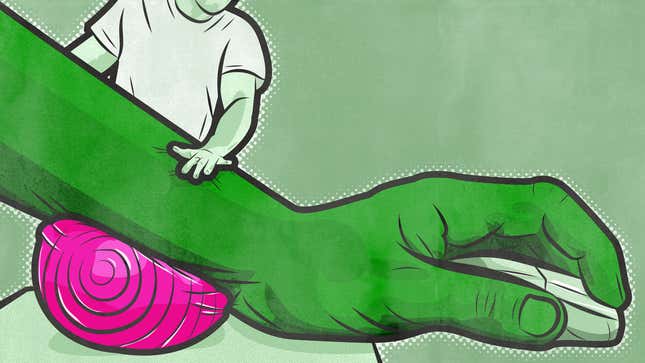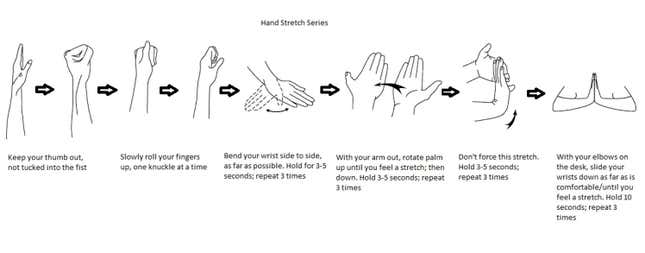
Clacking keys; mashing buttons; running joysticks up and down in precise, intricate patterns. The motions of playing a video game are mechanical—frequent and repetitive—and suggest a machine at work, which is of course not far off, especially with the best players in the world routinely spending 12 hours a day playing a game. Now, physical therapists are needed to keep the machines from breaking down.
Dr. Caitlin McGee works a day job at a hospital, dealing with everything from postoperative recovery to patients who have suffered brain injuries and strokes. She’s spent the last two years as a specialist in the field of physical therapy, after completing her master’s and doctorate at the University of Delaware. She also, though, travels to esports tournaments around the nation, working with teams and organizations to help players deal with the physical ramifications of playing competitive games, which, if not as drastic as those faced by, say, boxers or football players, are nonetheless very real.
It was a role she fell into backwards, after visiting Washington, D.C. and seeing a friend crunching statistics for the American broadcast of the Dota Asia championships.
“I had no idea what was going on, I had no idea what the game was or what the stats meant, but I was like, ‘This looks awesome and I wanna do it! Also, oh my God, their posture is terrible,’” said McGee. “That was how I discovered Dota. And, yes, the first competitive game I ever jumped into was Dota, because I’m a sane and rational human being.”

Working with tournament organizers, McGee helps players identity issues, deal with symptoms, and stay healthy for their next match. Though a little more glamorous than hospital work—“There’s a lot less bodily fluid involved,” McGee said—there’s still a great deal of similarity between her day job and weekend gig.
“You’re going to need to be creative in terms of adaptations to the plan you make, because the ideal plan for someone might be total rest for three weeks, with icing every day and starting this particular stretching and strengthening program,” said McGee. “And in reality, nobody’s going to do that if you tell them to do that in esports, so you need to find ways to optimize what you can get, and let people know when what they want to do is unfeasible, and work with them when what they want isn’t quite feasible, but can be tweaked.”
So what kind of injuries does McGee often deal with? Most frequently it’s tendinopathy, a level of inflammation or irritation or compression in the forearm that most players mistake for simply carpal tunnel. Other issues include postural deficits—pain or weakness caused by poor posture. McGee has seen players spend entire days in strange postures and positions, putting all kinds of pressure on unprotected nerves and tendons.
“I haven’t had anybody get to the point where they can’t play anymore,” said McGee. “Although I have had players where they are in enough pain that every hour, on the hour, I will go to the freezer, grab an ice pack and find them, wherever they are, and make them put the ice pack on.”
Many issues come from the ergonomics of playing games, something McGee and another physical therapist in the esports field, Matt Hwu, address in a video called Evidence-Based Esports. The current equipment in esports does not always provide good support, and often condones bad posture, especially when a player is practicing for hours on end.
In Super Smash Bros. specifically, certain players even develop extra muscle stress when playing certain characters. The bread-and-butter mechanics of playing Fox or Falco in Melee tend to stress certain parts of the forearm, causing tightness and tension.
“At this point, I can tell when someone has been playing a lot of Fox recently, just by poking their forearm when they’re at a Smash tournament,” said McGee. “I’m about 90 percent accurate, too. It’s pretty fun.”
The long hours players subject themselves to don’t help. Repetition is important for practice, but strains the muscles. Different pros will practice anywhere from 50 hours a week to 12 hours a day, making it difficult for physical therapists like McGee and Hwu, who works with Counter-Logic Gaming, to institute a regular regimen.
As McGee puts it, your body will, to an extent, adapt to the stresses that are applied to it. The same principle that allows ultramarathon runners to go for hundreds of miles supports esports players who are stretching their forearms, wrists, and tendons for hours on end, every day.
At some point, though, the limits of the body set in, and so do consequences. Esports is still a new field, and as the pioneers start to age out, seeing the repercussions of decades of play had on them will be a guiding factor for physical therapists. Players like Clinton “Fear” Loomis of Evil Geniuses have had to take extended breaks from the game to heal, and Melee player Aziz “Hax” Al-Yami had to undergo several surgeries to deal with persistent issues in his wrist, while fellow Melee player Jason “Mew2King” Zimmerman has complained of hand pain in the past. The frustrating thing is that there’s no quick or easy solution to the continued stresses of playing competitively. At some point, the body just shuts down.
“It will be interesting to see, because when it comes to traditional sports, there is a cap,” said McGee. “There’s a timeline on your career. You know that your body is only going stand up to these stresses you’re applying to it for so long. But the stresses in traditional sports are a little bit more dramatic. Think of a soccer player, doing the same pivots and cuts every day over time. It’s a little bit different in terms of intensity, although not in terms of repetition, from someone who’s gaming for a living.”
In the meantime, McGee and others are working with players as often as possible to set up the support structure they need to stay healthy. Teams like Complexity and OG stress fitness regimens, with the latter’s manager sitting in on McGee’s sessions with players in order to apply the same treatments later, when the team is boot camping or travelling. Hwu works with all of CLG’s rosters to keep them healthy, and Evil Geniuses, after issues with Loomis’s elbow, have been working with its players to stretch and stay healthy.
This is still a nascent field. There are very few dedicated physical therapists—probably not more than five, according to McGee’s estimates. She offers online consultation—with the caveat that no online service can perfectly diagnose a condition—and travels to tournaments. The onus for building a better support structure for players, however, will lie with the organizations and teams.
“There’s only so much you can figure out remotely, and I think that the way you would get that in-person care is for teams to essentially have what professional, traditional sports teams have,” said McGee. “A team athletic trainer or a physical therapist, someone in that capacity, acting both for prevention and for rehabilitation.”
For aspiring players, McGee offers simple advice: Pay attention to pain when it starts, and address the cause. Keep good posture. Eat healthy. And, above all, don’t be afraid to ask. Though there aren’t many of them, there are physical therapists like McGee working to create the resources and tools needed to, as her site says, “play more, hurt less.”